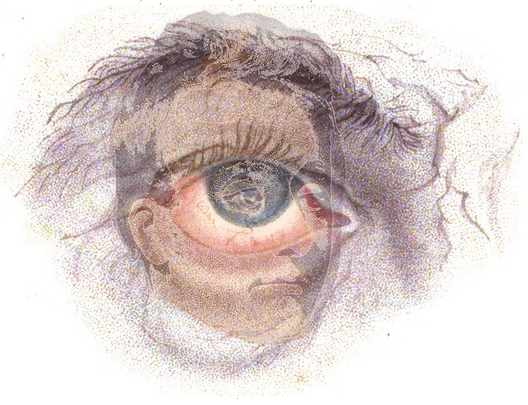James Wardrop1782–1869
Wardrop has been referred to as the founder of ophthalmic pathology. His portrait is shown focussed on the eye that he illustrated in his Essays on the Morbid Anatomy of the Human Eye published in 1808. He continued researching aspects of vision after his move to London and made valuable contributions to understanding binocular vision. For example, he argued that the fibres from each eye did ‘intermingle’ at the optic chiasm before reaching the cortex. He also speculated about eye dominance and binocular single vision: “It will generally be found, that not only the right is more perfect than the left eye, but when a person is apparently looking at an object with both eyes, generally only one of the eyes, and that usually the right one, is directed to the object. To demonstrate this, let a spot be covered with the point of a finger when looking at it with both eyes. If the left eye be closed, the point of the finger will continue to appear to cover the spot, and to preserve the same relative situation; but if the right eye be closed and the left opened, then the relative situation of the point of the finger and spot appear altered, the spot being uncovered; proving that, in directing the finger to cover the spot, the right eye had alone been employed.” However, it was with respect to vision following cataract removal that he made his mark. Wardrop gave an account of a lady who had her sight restored at the age of 45. Her vision from birth was defective, probably due to cataract, but blindness ensued following unsuccessful operations to remove them in her first year. One eye retained gross vision of light and dark, and it was on this eye that Wardrop performed three operations, the results of which he reported: “Eighteen days after the last operation had been performed, I attempted to ascertain by a few experiments her precise notions of the colour, size, forms, position, motions, and distances of external objects. As she could only see with one eye, nothing could be ascertained respecting the question of double vision. She evidently saw the difference of colours; that is, she received and was sensible of different impressions from different colours. When pieces of paper one and a half inch square, differently coloured, were presented to her, she not only distinguished them at once from one another, but gave a decided preference to some colours, liking yellow most, and then pale pink. It may be here mentioned, that when desirous of examining an object, she had considerable difficulty in directing her eye to it, and finding out its position, moving her hand as well as her eye in various directions.... she not only distinguished small from large objects, but knew what was meant by above and below... She could also perceive motions... She seemed to have the greatest difficulty in finding out the distance of any object; for when an object was held close to her eye, she would search for it by stretching her hand far beyond its position, while on other occasions she groped close to her own face, for a thing far removed from her.” Wardrop assisted greatly in the transition from oculists to ophthalmologists.
